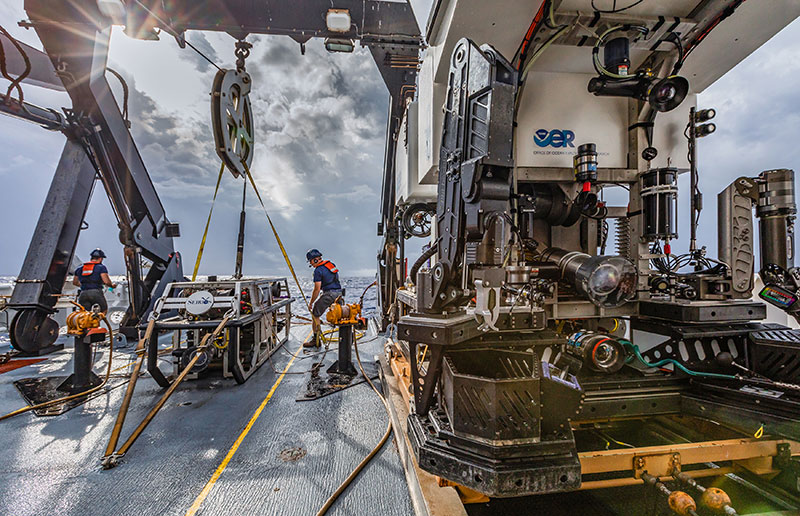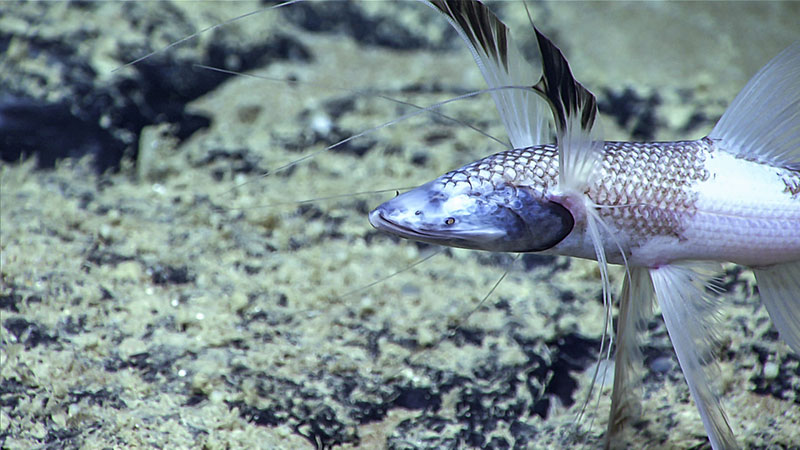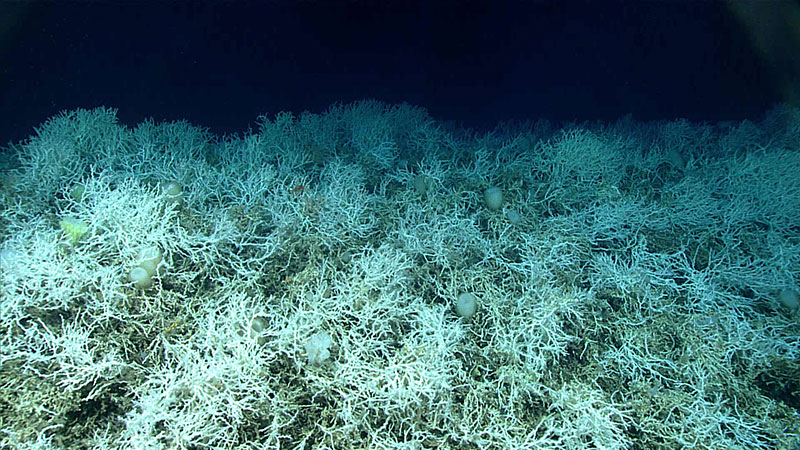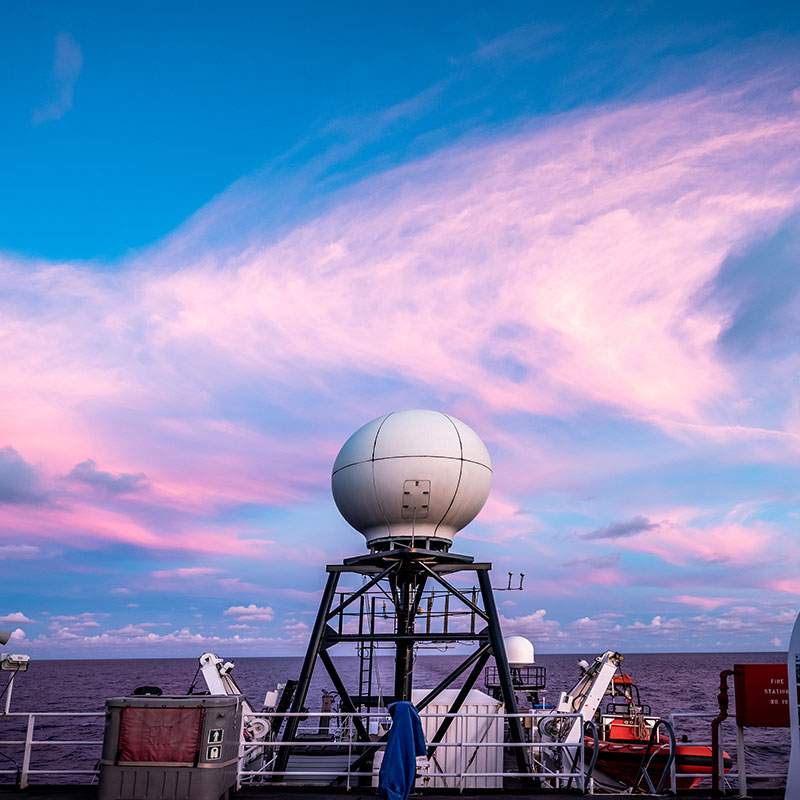
by Mike White, Expedition Manager, NOAA Office of Ocean Exploration and Research
Derek Sowers, Expedition Coordinator and Mapping Lead, NOAA Office of Ocean Exploration and Research
Shannon Hoy, Mapping Lead, NOAA Office of Ocean Exploration and Research
Stephanie Farrington, Biology Science Lead, Harbor Branch Oceanographic Institute at Florida Atlantic University
Kimberly Galvez, Geology Science Lead, University of Miami, Rosenstiel School of Marine and Atmospheric Science
Scott France, Okeanos Explorer Science Advisor, University of Louisiana at Lafayette

An ophiuroid brittle star hangs out in the branches of a Metallogorgia octocoral. Image courtesy of the NOAA Office of Ocean Exploration and Research, Windows to the Deep 2018. Download larger version (jpg, 1.3 MB).
From October 31 through November 20, 2019, NOAA and partners will conduct the second part of a two-part telepresence-enabled ocean exploration expedition on NOAA Ship Okeanos Explorer to collect critical baseline information about unknown and poorly understood deepwater areas of the U.S. Southeast. As with previous Okeanos Explorer expeditions, NOAA will work closely with the science and resource management communities to explore priority deepwater areas. The deep waters off the U.S. Southeast remain the most poorly mapped and characterized areas on the U.S. East Coast and contain a wide diversity of poorly explored deepwater habitats and geological features that are of interest to resource managers and scientists, including biogenic mounds, deep-sea coral and sponge habitats, and fish habitats.
The 2019 Southeastern U.S. Deep-sea Exploration expedition includes two parts. The first part took place from October 5 to October 26, 2019, with 24-hour-a-day mapping operations using the ship’s deepwater mapping systems (Kongsberg EM 302 multibeam sonar, Simrad EK 60 and EK 80 split-beam fisheries sonars, Knudsen 3260 chirp subbottom profiler sonar, and Teledyne acoustic Doppler current profilers) to collect baseline seafloor and water column data. Mapping data collected during this part of the expedition will further improve our understanding of this region. In addition, we will use these data to help plan the remotely operated vehicle (ROV) dives.
The second part of the expedition will build on mapping data collected during the first part to further explore this region. From October 31 to November 20, we will use NOAA's dual-body ROV, which is capable of diving to depths of 6,000 meters (3.7 miles), to explore a diversity of poorly known deep seafloor and midwater habitats, as well as unique geological features. Operations will include unexplored areas of the Blake Plateau, Blake Ridge, Blake Escarpment, and carbonate terraces around Florida. The ROV dives will enable scientists and managers to build a better understanding of the diversity and distribution of deepwater habitats in this region, allowing for informed resource management decisions. Additionally, the expedition will use the ship’s high-bandwidth satellite connection to engage a broad spectrum of scientists, resource managers, and the public in telepresence-based exploration.

This 2019 Southeast U.S. Deep-sea Exploration - ROV and Mapping overview map shows ROV dive locations, which will be finalized with input from the community. Overnight mapping operations will add additional mapping data in areas that are poorly mapped. Image courtesy of the NOAA Office of Ocean Exploration and Research. Download larger version (jpg, 5.1 MB).
The 2019 U.S. Southeast Deep-sea Exploration will be one of several expeditions taking place in 2018-2020 that will contribute directly to the Atlantic Seafloor Partnership for Integrated Research and Exploration (ASPIRE) campaign, a major multiyear, multinational collaborative field program focused on raising our collective knowledge of the North Atlantic Ocean. The North Atlantic is of vital importance to humankind, providing a variety of goods and services (e.g., seafood, recreation, tourism, and transportation) that provide employment and livelihood opportunities for millions of people. Despite its critical importance, we have only begun to understand the region’s deep-sea resources, oceanography, bathymetry, geology, ecosystems, and trans-Atlantic biological connectivity.

The remotely operated vehicle Deep Discoverer will be used to image unexplored areas of the Blake Plateau, Blake Ridge, Blake Escarpment, and deep-sea areas off the coast of Georgia, South Carolina, and Florida. Image courtesy of the NOAA Office of Ocean Exploration and Research, Windows to the Deep 2019. Download larger version (jpg, 7.1 MB).
This expedition builds on previous expeditions, including 2003 Windows to the Deep, Windows to the Deep 2018, Windows to the Deep 2019, and the DEEP SEARCH (DEEP Sea Exploration to Advance Research on Coral/Canyon/Cold seep Habitats) expeditions. These expeditions have contributed greatly to what we now know about environments along the edge of the Southeastern U.S. continental margin. Every square kilometer of seafloor mapped and ROV dive add to our collective knowledge of deep-sea environments and help to improve our understanding of this region.

A tripod fish (Bathypterois grallator) props itself up on the seafloor. The tripod fish was observed during Windows to the Deep 2019, a previous NOAA expedition to the U.S. Southeast. Image courtesy of the NOAA Office of Ocean Exploration and Research, Windows to the Deep 2019. Download larger version (jpg, 1.3 MB).
NOAA priorities for the expedition include a combination of science, education, outreach, and open-data objectives that will provide a better understanding of this important marine region. Specific objectives include:

Dense fields of Lophelia pertusa, a common reef-building coral, have been found on the Blake Plateau knolls. The white coloring is healthy - deep-sea corals don’t rely on symbiotic algae, so they can’t bleach. Similar areas will be targeted for ROV dives on the upcoming expedition. Image courtesy of the NOAA Office of Ocean Exploration and Research, Windows to the Deep 2019. Download larger version (jpg, 1.8 MB).
Telepresence technology allows us to engage the majority of the science team from shore. NOAA uses telepresence technology to transmit data in real time to a shore-based team of scientists who actively participate in expeditions. Scientists participating from around the world contribute their expertise to operations in real time when discoveries are made at sea.
These shore-based scientists interact with the ship through a teleconference line and Internet collaboration tools. Using these communication tools, scientists and students help guide at-sea operations in real time, extending the reach of ocean exploration to more scientists and students than could possibly be accommodated on any single vessel.

The sun sets over the VSAT, or Very Small Aperture Terminal, antenna that allows for real-time sharing of our exploration data and live video through telepresence. Image courtesy of Art Howard, Global Foundation for Ocean Exploration, NOAA Office of Ocean Exploration and Research, Windows to the Deep 2019. Download larger version (jpg, 5.8 MB).
During the expedition, several scientists will also work together and stand watch at exploration command centers (ECCs). When Okeanos Explorer expeditions first started, ECCs were the only way that scientists could engage with the ship in real time. With advances in technology, scientists with an Internet connection can now participate in an expedition no matter where they are. Nevertheless, many scientists still prefer to be co-located with their colleagues at an ECC, as it is the closest atmosphere to being in the collaborative environment that naturally forms on a ship. Also, working from an ECC removes scientists from their busy lives and allows them to focus on the expedition.
Anyone with an Internet connection can follow along with the expedition, as high-definition video of the dives will be streamed live over the Internet from November 1 through November 19, 2019. The same telepresence technology that allows scientists from around the world to participate in the expedition from land will also enable interested members of the public to experience deep-sea exploration, the wonder of discovery, and the fascination of science in real time. Additionally, mission logs, daily updates, educational materials, and images and videos will be added to the Ocean Explorer website throughout the expedition. Highlight images, videos, and other information from the expedition will also be posted daily to the OER Facebook , Instagram , and Twitter accounts.